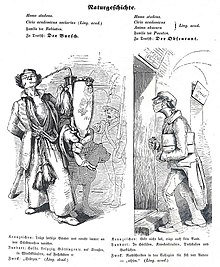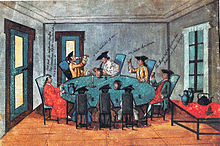Student customs


For student traditions are diverse, partly existing since the Middle Ages customs , rituals , behaviors, customs, ceremonies and festivals that the student life shaped and to varying degrees in most universities still exist today.
In the German-speaking countries , the student-specific customs largely dissolved in the course of the 1968 student movement and opened up to general youth culture . It is still particularly well looked after in traditional student associations . The historical customs of the students are researched by student historians and documented in student museums.
Student customs in German-speaking countries
Expression
From the Middle Ages until well into the 1960s (apart from the time of National Socialism ), the life of students was very different from that of other young people in their age group. Since the university made such extensive student-specific social role offers , the sociologist Klaus Allerbeck characterized the "student being" at the time as a " total role ", which only developed into a socially differentiated role among others in the 1970s.
Corresponding to this total role, a specific student tradition developed, which was expressed in numerous special behaviors. These included, for example, forms of approval or rejection such as applause , scratching, hissing or bringing out vivat or pereat , excerpts and elevators, county and entrance escort, torchlight procession, cat music , beer states and the maintenance of social life. This also includes special student card games such as Quodlibet . Also a student language with its own styling ( Mr. classmate ) was one of them. Likewise were student songs and the student fencing long time important elements of student traditions in Central Europe.
To student life and its customs were also students prisons ( detention room ) because of its own jurisdiction of the universities, funerals for professors and students, student communities , students, sports, student hostels , student dining halls , student newspapers ( students Courier ), student theater, orchestras ( Collegium Musicum Instrumental ), choirs ( Collegicum Musicum Vocale ) and cabarets.
history
In the early 15th century, the custom of deposition , already known in Paris and Bologna, was also introduced in Germany. This was a traditional, semi-official initiation ritual for students that lasted until the 18th century. The ritual preceded enrollment at a university and included removing the horns before entering the university.
In the 16th and 17th centuries, student life was shaped by the custom of Pennalism , an employment relationship between younger and older students in the student country teams .
With the increasing development of a student status in the Holy Roman Empire of the early modern period, which also found its expression in the use of a sword , a student duel system developed , from which the current scale emerged in the 19th century .
A student custom in the 18th century at German universities was the hospitium , where a student acted as a host and could let his fellow students drink.
In the 18th century, the custom of provincial stinging arose , in which students - originally in honor of their sovereign - jointly pierce their hats with the blade of a sword (or later a bat ).
In the 19th century in particular, student associations shaped student life with their own insignia such as coats of arms and circles , public appearances in hats and ribbons and special celebrations such as pubs and foundation festivals . Even from pre-industrial times, the social stratification came from the fox as "beginners", boys as "fully active" members and old men as "former", who also financially supported the Burse (hence the stock exchange ).
See also
- Scholar
- Carmina Burana
- Archipoeta
- Cornelius Relegatus
- Strolling student
- Natural portrayal of academic life
- Jobsiade
literature
- Gaudeamus Igitur . Student life then and now. Exhibition catalog, Schallaburg. Vienna 1992, DNB 930452399 .
- Peter Krause : "O old lad glory." The students and their customs. Verlag Styria, Graz / Vienna / Cologne 1997, ISBN 3-222-12478-7 .
- Matthias Stickler : University as a way of life? Thoughts on the self-regulation of student socialization in the long 19th century. In: Rüdiger vom Bruch (Ed.): The Berlin University in the Context of the German University Landscape. Oldenbourg Wissenschaftsverlag, 2010, ISBN 978-3-486-59710-3 .
- Oskar Dolch: History of German students - from the founding of German universities to the German wars of freedom. Photomechanical reprint of the Brockhaus Leipzig edition, published in 1858 by Verlag für Collectors, Graz 1968.
- Paulgerhard Gladen : Gaudeamus igitur - The student connections then and now. Munich, Callwey, 1988, ISBN 3-7667-0912-7 .
- Friedhelm Golücke et al. i. A. the community for German student history eV: Richard Fick (Ed.): On Germany's high schools. Photomechanical reprint of the Berlin 1900 edition, SH-Verlag, Cologne, 1997, ISBN 3-89498-042-7 .
- Robert Paschke: Student History Lexicon. GDS archive for university history and student history, supplement 9, Cologne, 1999, ISBN 3-89498-072-9 .
- Gerhard Richwien: To be a student. A little cultural history. Association for German Student History (GDS), Kleine Schriften der GDS 15, SH-Verlag, Cologne, 1998, ISBN 3-89498-049-4 .
- Friedrich Schulze / Paul Ssymank : German studenthood from the oldest times to the present. 4th edition 1932, Verlag für Hochschulkunde Munich.
- Max Bauer: Moral history of the German student body. Dresden undated (approx. 1930).
- Michael Klant: University in the caricature - evil images from the curious history of the universities. Hanover 1984, ISBN 3-7716-1451-1 .
- Karl Konrad: Imagery of the German student system. 2nd edition, Breslau 1931; Supplements and additions, Breslau 1935.
- Helga-Maria Kühn : Student life in Göttingen in the 18th century according to contemporary reports, letters, travelogues and files from the city archive. In: Göttingen in the 18th century. A city changes its face. Texts and materials for the exhibition in the Städtisches Museum and Göttingen City Archives April 26–30. August 1987. Göttingen 1987, pp. 145-181.
- Konrad Lengenfelder (ed.): Dendrono-Puschner's natural portrayal of academic life in beautiful figures brought to light. 2nd edition Altdorf 1993 (1st edition Nuremberg 1962).
- Paul Ssymank : Brother Studio in Caricature and Satire. Stuttgart 1929.
- Wolfgang EJ Weber: History of the European University. Kohlhammer, Stuttgart 2002, ISBN 3-17-016482-1 .
- Konrad H. Jarausch : German Students 1800–1970. Frankfurt a. M. 1984.
- Hans Peter Hümmer : The "Burschen-Comment" of Martialis Schluck von Raufenfels. The Latin version from 1780 and the first German translation from 1798. Einst und Jetzt , Vol. 52 (2007), p. 29.
- Michaela Neubert , Matthias Stickler: Diversity and change in student clothing as reflected in the collections of the Institute for Higher Education at the University of Würzburg . Once and Now, Vol. 65 (2020), pp. 33-88.
Web links
- Mag.Joh.Dinkel: Speech about the origin, reasons, role model and ceremonies of the rite, which is generally called deposition in the (high) schools. Erfurt 1569.
- Norbert Nail: About the academic custom of deposition in Marburg
- Stud. Customs especially in Austria
Individual evidence
- ^ Klaus Allerbeck : Sociology of radical student movements . Oldenbourg, 1973, ISBN 3-486-43971-5 , pp. 220ff.

